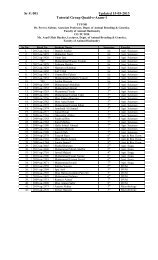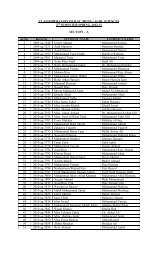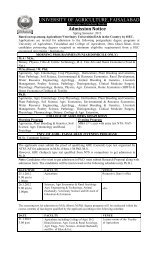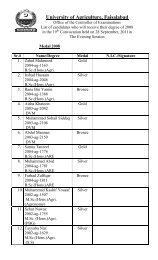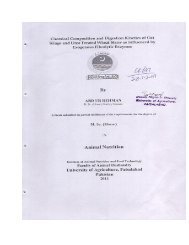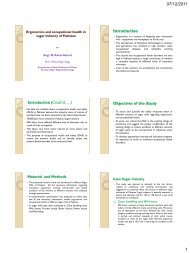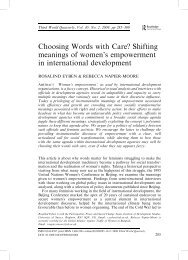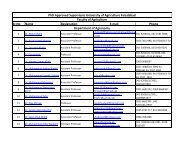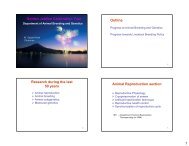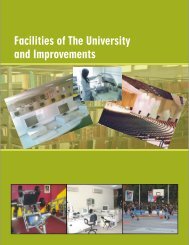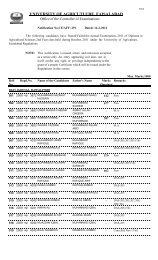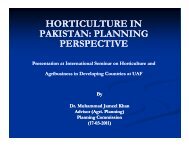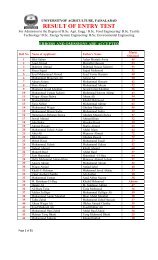Bio-Power as Alternative Energy Resource For ... - icdd@uaf.edu.pk
Bio-Power as Alternative Energy Resource For ... - icdd@uaf.edu.pk
Bio-Power as Alternative Energy Resource For ... - icdd@uaf.edu.pk
Create successful ePaper yourself
Turn your PDF publications into a flip-book with our unique Google optimized e-Paper software.
BIO-POWER<br />
AS<br />
ALTERNATIVE ENERGY RESOURCE<br />
FOR RURAL COMMUNITY IN PAKISTAN<br />
BY<br />
DR. MUHAMMAD ASHRAF<br />
ASSTT: AGRI. ENGINEER (RESEARCH)<br />
AGRICULTURAL MECHANIZATION RESEARCH<br />
INSTITUTE<br />
DIVISION FAISALABAD
THE MOST BURNING ISSUE OF THE DAY<br />
IN<br />
AGRICULTURE SECTOR<br />
• <strong>Energy</strong> (Diesel, Electricity, G<strong>as</strong>)<br />
• Water (for irrigation)<br />
Water sources in Pakistan<br />
◦ Rainfall<br />
◦ Surface water from the Rivers, Canals<br />
◦ Ground water
Water<br />
• Surface water availability (Normal) 103.5 MAF<br />
• Surface water available (2009-10) 93.3 MAF<br />
• Surface water short fall (2009-10) 9.9 MAF<br />
• Expected water short fall by 2013 108 MAF<br />
• Rain fall (2009-10)<br />
Rainfall Mon son Winter<br />
(mm)<br />
(mm)<br />
Normal 137.5 70.5<br />
Actual 101.8 49.2<br />
Shortfall 26% 30.2%
Ground Water<br />
Due to insufficient supply of surface water for irrigation<br />
ground water pumping with tube well in Pakistan is a<br />
2 nd major source of water.<br />
Tube well in Pakistan<br />
• Diesel Tube Well 545,000<br />
• Electric tube wells 84,000
FUEL CONSUMPTION<br />
Three power source for tube well operation<br />
1. Diesel tube well (Peter Engines)<br />
1.5-2.5 liters per hour<br />
2. Tractor operated tube wells<br />
3.5-5.0 liter per hour<br />
3. Electric tube well, on an average, are<br />
8 units per hour (with 10 horsepower motor).
Tube Well Operation Cost<br />
Diesel Consumption/annum<br />
◦ 950 million liters,<br />
◦ 87 billions rupees<br />
Electric tube wells/annum<br />
◦ 1.02 billion kilo watt-hours (kwh)<br />
◦ 26 billions rupees<br />
Total energy cost/annum<br />
◦ 113 billion rupees (for tube well operation)
Tractor Operation Cost<br />
• Farm energy source<br />
• Tractors (Approx) 600,000 +<br />
• Diesel consumption<br />
6 liters/hour (Average)<br />
• Annual diesel consumption (Approx)<br />
6000lit/tractor<br />
• Total diesel consumption 3600 million liters<br />
• Total energy cost/annum (Estimated)<br />
◦ 330 billion rupees (for tractor operation)
Bottle Necks and Solutions<br />
◦ High rate of fuel and electricity<br />
◦ Sch<strong>edu</strong>led and unsch<strong>edu</strong>led load shedding of<br />
electricity<br />
◦ Un availability of diesel<br />
We have to go to the<br />
Alternate energy resources<br />
◦ <strong>Bio</strong>g<strong>as</strong> (<strong>Bio</strong>g<strong>as</strong> is a source of green renewable energy)<br />
◦ Solar<br />
◦ Wind<br />
What we Do?
Solution<br />
?<br />
<strong>Bio</strong>g<strong>as</strong>
What is biog<strong>as</strong>?<br />
• <strong>Bio</strong>g<strong>as</strong> is produced by the breakdown of organic w<strong>as</strong>te by<br />
bacteria without oxygen (anaerobic digestion).<br />
• . Methane (CH 4 ) 40-75%<br />
• Carbon dioxide (CO 2 ) 25-55%<br />
• Hydrogen sulfide (H 2 S) 50-5000ppm<br />
• Ammonia (NH 3 ) 0-1%<br />
• Water (H 2 O) 0-10%<br />
• Nitrogen (N 2 ) 0-5%<br />
• Oxygen (O 2 ) 0-2%<br />
• Hydrogen (H 2 ) 0-1%
We have the potential<br />
‣ Pakistan is agro-b<strong>as</strong>ed country<br />
‣ Total cropped area in Pakistan is about 22.2 million ha.<br />
‣ Available crop residue in Pakistan 69 million tons/annum<br />
‣ <strong>Bio</strong>m<strong>as</strong>s can generate 45,870 million kwh electricity per year<br />
‣ Available animals in Pakistan 65 Millions (Approx)<br />
‣ Available animal dung 650 Million Kg/day<br />
‣ Collectable dung 325 Million kg/day (50% Collectability)<br />
‣ Pakistan can generate 16.25 million m 3 /day of biog<strong>as</strong><br />
‣ Pakistan can generate 9885 million kwh electricity per year<br />
‣ Estimated bio fertilizer production is 12 million tones per year<br />
‣ It can e<strong>as</strong>ily compensate around 20-30 % of fertilizer requirement in the crop<br />
fields.<br />
‣ Pakistan h<strong>as</strong> almost 3,000 MW power generation potential in sugar industry<br />
while producing only 700 MW
Misuse of potential<br />
and<br />
Environmental Effects<br />
‣ Deforested area 7000 ha/year for burning in any form<br />
‣ Approximately 1/3 of collectable dung (156 Million<br />
kg/day) is used for dung cake making for domestic<br />
burning and 2/3 rd of collectable dung is open dumped<br />
for manure.<br />
‣ Available energy from animal dung cake only 11%.<br />
‣ More than 50% of crop residue is burnt causing the<br />
environment pollutions and retarding the favourable<br />
microbial activities in soil.
Traditional making of dung cake
Misuse of potential<br />
and<br />
Environmental Effects<br />
‣ All the sources (forests, crop residue, animal dung cake,<br />
etc) either burnt or aerobically decomposed causes<br />
environmental pollution.<br />
‣ Each year some 590-880 million tons of methane is<br />
rele<strong>as</strong>ed worldwide into the atmosphere through<br />
microbial activity.<br />
‣ Contribution of a methane (CH 4 ) to the greenhouse effect<br />
is 21 times greater than that of a carbon dioxide.
History of <strong>Bio</strong>g<strong>as</strong> technology in<br />
Pakistan<br />
• History of <strong>Bio</strong>g<strong>as</strong> in Pakistan is about 35 years old<br />
• Around 7000 digesters have reportedly been installed across the<br />
country.<br />
• Technical potential of about 5 million digesters.<br />
• Government of Pakistan started comprehensive biog<strong>as</strong> scheme in<br />
1974 and total 4,137 biog<strong>as</strong> plants installed up-to 1987. These<br />
are Floating drum biog<strong>as</strong> plants with capacity 5-15 cubic meters<br />
g<strong>as</strong> production per day.<br />
• Pakistan Centre for Renewable <strong>Energy</strong> Technologies (PCRET)<br />
Installed of around 2500 biog<strong>as</strong> plants till the end of 2008.
History of <strong>Bio</strong>g<strong>as</strong> technology in<br />
Pakistan<br />
• NGO, (IRSD) installed 150 biog<strong>as</strong> plants with support from<br />
the UNDP.<br />
• NGO ‘Koshis’ helped villagers to build over 200 biog<strong>as</strong> plants<br />
in Sialkot district.<br />
• In June of 2007, PRSP installed 12 Dome type <strong>Bio</strong>g<strong>as</strong> plants in<br />
tehsil P<strong>as</strong>rur of Sialkot with help of Foundation for Integrated<br />
Development Action (FIDA)<br />
• 1982 to 1985, 1000 Nos. of biog<strong>as</strong> plants were installed in<br />
various districts of the Punjab by the Pakistan Council of<br />
Appropriate Technology with collaboration of Agriculture<br />
Department (Field Wing).
History of <strong>Bio</strong>g<strong>as</strong> technology in<br />
Pakistan<br />
• 2009-2010 Agriculture department (Field Wing) launched<br />
a programme “Adaptation of <strong>Bio</strong>g<strong>as</strong> technology to<br />
mitigate the energy crises” to install 750 Nos Family<br />
Size <strong>Bio</strong>g<strong>as</strong> Plants all over the Punjab, this project is in<br />
progress.<br />
• In District Faisalabad PRSP installed 500 Nos <strong>Bio</strong>g<strong>as</strong><br />
plants under PDBP (Pakistan Domestic <strong>Bio</strong>g<strong>as</strong><br />
Programme.<br />
• Some medium size <strong>Bio</strong>g<strong>as</strong> plants have been installed in<br />
private sector to meet the energy requirements for<br />
◦ tube well operation for agriculture purpose,<br />
◦ cooking and lighting for domestic purpose, and<br />
◦ electricity generation for small industry operation during load<br />
shedding.
B<strong>as</strong>ic Design of <strong>Bio</strong>g<strong>as</strong> Plants<br />
• <strong>Bio</strong>g<strong>as</strong> plants installed by different organizations<br />
are:<br />
1. Drum type <strong>Bio</strong>g<strong>as</strong> Plant<br />
(Constant Pressure b<strong>as</strong>is)<br />
2. Dome type <strong>Bio</strong>g<strong>as</strong> Plant<br />
(Constant Volume b<strong>as</strong>is)<br />
• Almost all biog<strong>as</strong> plants are simple and accessories like<br />
Stirring, heat exchanger, compressor and storage reservoir<br />
have not been provided to the biog<strong>as</strong> plant
Drum type <strong>Bio</strong>g<strong>as</strong> Plants<br />
• Experimental <strong>Bio</strong>g<strong>as</strong> plants<br />
• Family size <strong>Bio</strong>g<strong>as</strong> plants<br />
• Medium size biog<strong>as</strong> plants
Family Size <strong>Bio</strong>g<strong>as</strong> Plant<br />
(Drum type)
Family size <strong>Bio</strong>g<strong>as</strong> plant<br />
• G<strong>as</strong> production 4-5 m 3<br />
• G<strong>as</strong> consumption<br />
0.5 m 3 /head/day<br />
(for cooking and lighting)<br />
• Average family size<br />
8 members<br />
• G<strong>as</strong> consumption/family/day 4.0 m 3<br />
• Estimated N @ 1.84 % 2.13 kg/day<br />
• Estimated P @ 1%<br />
1.16 kg/day<br />
• Estimated K @ 1%<br />
1.16 kg/day<br />
• Estimated NPK /day/plant 4.45 kg/day<br />
1625 kg/annum/plant
Factors affecting <strong>Bio</strong>g<strong>as</strong> generation<br />
1. pH concentration<br />
2. Temperature<br />
3. Total solid content of the feed material<br />
4. Loading rate<br />
5. Uniform feeding<br />
6. Diameter to depth ratio<br />
7. Carbon to nitrogen ratio<br />
8. Nutrients<br />
9. Mixing or stirring or agitation of the digester<br />
10. Retention time or rate of feeding<br />
11. Type of feed stocks<br />
12. Toxicity due end product<br />
13. Acid accumulation inside the digester.
Domestic cooking with <strong>Bio</strong>g<strong>as</strong>
A Step Ahead<br />
Family size to Medium <strong>Bio</strong>g<strong>as</strong> plants for<br />
• Small industry<br />
• Electricity generation<br />
• Community use<br />
• Tube well operation
<strong>Bio</strong>g<strong>as</strong> plant sites<br />
• Al- Hamad Exports<br />
Sityana Road Faisalabad<br />
• Ashraf Zia Textile industries<br />
Khurrianwala- Jaranwala Road Faisalabad<br />
• JK Farms<br />
Jumera Road Faisalabad<br />
• Tahir Dairy Farm<br />
128 RB Wahley Chak Jumera Road Faisalabad
Medium Size <strong>Bio</strong>g<strong>as</strong> Plant<br />
(Al-Hamad Exports Sityana Road Faisalabad)
<strong>Bio</strong>g<strong>as</strong> Plants at Al - Hamad Exports<br />
Sityana Road Faisalabad<br />
• Feed rate 1.5 t/day<br />
• G<strong>as</strong> production 30-35 m 3 /day<br />
• G<strong>as</strong> utilization<br />
• Cooking<br />
• Electricity generation to address load shedding<br />
Equipments<br />
‣Stirring system (Mechanical)<br />
‣Heat exchanger (Hot water circulation)<br />
‣Compressor<br />
‣Additional g<strong>as</strong> reservoir<br />
‣G<strong>as</strong> regulator<br />
‣Electric generator (Dual Fuel System)
Gen. Muhammad Ali (Chief Executive)<br />
Live Stock and Dairy Development Board
Gen. Awais is visiting site
Flame of <strong>Bio</strong>g<strong>as</strong>
Electricity generation<br />
(Dual Fuel System)
Organic Fertilizer from BGM
<strong>Bio</strong>g<strong>as</strong> Plants JK Farms
<strong>Bio</strong>g<strong>as</strong> plants JK farms<br />
• Design Constant pressure b<strong>as</strong>ed<br />
• No of plants two<br />
• Feeding rate 3t/day/plant<br />
• G<strong>as</strong> production 60-70 m 3 /plant/day (expected)<br />
• Equipments<br />
• Heat exchanger (Hot water circulation)<br />
• Stirring system (Mechanical /electrical)<br />
• Compressor<br />
• Additional storage reservoir<br />
• <strong>For</strong>ced flow circulatory feeding system
<strong>Bio</strong>g<strong>as</strong> produced will be used<br />
At Farm house for<br />
◦ Cooking<br />
◦ Heating ( heat exchanger and other appliances)<br />
◦ Electricity generation (25 kvA)<br />
◦ Tube well operation (on dual fuel system)
Construction of fermentation Chamber<br />
<strong>Bio</strong>g<strong>as</strong> plant at JK Farms
At site Manufacturing of Fibre Gl<strong>as</strong>s G<strong>as</strong> Holder<br />
JK Farms Faisalabad
Heat exchanger installation in Fermentation<br />
Chamber at Ashraf - Zia Industries
Compressor for <strong>Bio</strong>g<strong>as</strong> plant
Instrumentation to <strong>as</strong>certain the Drum<br />
movement At Ashraf Zia Textile Industries
G<strong>as</strong> Compressor and G<strong>as</strong> Storage<br />
(Ashraf-Zia Textile industries)
Feeding Tank and Mixing system<br />
(Gravity Flow)
Dome Type <strong>Bio</strong>g<strong>as</strong> Plant (Tunnel Shaped)<br />
Tahir Dairy Farm 128 RB Wahley Chak Jumera Road Faisalabad
Electricity Generator (15 kvA)<br />
(Dual Fuel System)
Gear Pump Type <strong>For</strong>ced flow<br />
circulatory mixing feeding system
Inspection of Hairline Cracks in Dome
Hairline Cracks in Dome
Tube Well operation on Dual Fual System
Tube well operation operation on Dual Fuel System<br />
(<strong>Bio</strong>g<strong>as</strong>+Diesel)
Cost-Benefit Analysis of <strong>Bio</strong>g<strong>as</strong> plant
DESIGN OF BIOGAS PLANT FOR<br />
TUBE WELL OPERATION<br />
• Inner Dia. Of fermentation chamber<br />
• Depth of fermentation chamber<br />
16 ft<br />
14 ft<br />
• Volume of fermentation chamber 2966.37 ft 3<br />
• Total weight of feeding material 84000 kg<br />
(fermentation chamber)<br />
• Retention times<br />
42 days<br />
(inc<strong>as</strong>e of controlled temperature RT will be in the range 20-25 days<br />
that will change of feeding rate and g<strong>as</strong> production)<br />
• Dia. Of feeding tank 4.0 ft (1.22 m)<br />
• Depth of feeding tank 4.5 ft (1.37 m)<br />
• Capacity of feeding tank 1.5 m 3
• Feeding material/day 84000/42 2000 kg<br />
• Slurry (water: animal dung) 1:1<br />
• Animal dung required per day/plant 1000 kg<br />
• Water required /day 1000 kg<br />
• Animal required/plant 70-100<br />
(b<strong>as</strong>ed on collect ability)<br />
• G<strong>as</strong> production/day/plant 50 m 3<br />
• G<strong>as</strong> production (65-70% plant efficiency) 35 m 3<br />
• Dia. Of g<strong>as</strong> holder 15.5 ft<br />
• Height of g<strong>as</strong> holder 4 ft<br />
• Type of mixer (feeding tank) mechanical<br />
• Stirring system (fermentation chamber) mechanical<br />
• Heat exchanger hot water circulation<br />
( consume 10% of daily g<strong>as</strong> production in winter)
• Average g<strong>as</strong> consumption/person/day 0.5 m 3<br />
(for cooking and lighting)<br />
• Average family size<br />
8 members<br />
• Total g<strong>as</strong> consumption/family/day 4.0 m 3<br />
• G<strong>as</strong> consumed by a family in 3 days 12 m 3<br />
• Total G<strong>as</strong> Production by Plant in 3 days 105 m 3<br />
• G<strong>as</strong> available for tube well operation 93 m 3<br />
• Tube well engine power (<strong>as</strong>sumptions) 20 hp<br />
• G<strong>as</strong> consumption/hr 9 m 3<br />
• Tube well operation duration<br />
10 Hrs
A tube well (20 hp Engine) of 1 cusec<br />
discharge will be operated twice (10<br />
hrs each) in a week and a family of 8<br />
family members will also be<br />
accommodated for cooking and<br />
lighting purpose.
CATTLE HOLDING STATUS IN PAKISTAN<br />
Pakistan<br />
Punjab<br />
Animals Range H.H Total Animals H.H Total Animals<br />
1-2 2667710 4405000 1695492 2733198<br />
3-4 1699983 5938722 1005454 3477822<br />
5-6 836347 4555829 446042 2419996<br />
7-10 618948 5063011 278734 2253712<br />
11-15 207073 2597817 73423 916016<br />
16-20 69744 1234484 20568 363317<br />
21-30 46100 1132365 14570 359700<br />
31-50 23838 923390 7580 287657<br />
51- above 18531 3708204 8166 1600913
A study conducted l<strong>as</strong>t year revealed that<br />
• <strong>Bio</strong>g<strong>as</strong> production w<strong>as</strong> incre<strong>as</strong>ed up to 15% and<br />
20% with addition of 10% poultry w<strong>as</strong>te and<br />
sugar mud respectively.
General Benefits of technology<br />
• Jump-start new biomethane g<strong>as</strong> production<br />
• Begin the creation of the biomethane infr<strong>as</strong>tructure<br />
and biomethane industry<br />
• Incre<strong>as</strong>e biomethane “reserves”<br />
• Creation of green jobs<br />
• Expand the rural economy and incre<strong>as</strong>e revenues for<br />
farming and agricultural operations<br />
• Incre<strong>as</strong>e energy independence<br />
• R<strong>edu</strong>ce greenhouse g<strong>as</strong> emissions.
Specific Benefits of technology<br />
‣ Production of energy (heat, light, electricity).<br />
‣ Transformation of organic w<strong>as</strong>tes into high quality<br />
fertilizer.<br />
‣ Improvement of hygienic conditions through<br />
r<strong>edu</strong>ction of pathogens, worm eggs and flies.<br />
‣ R<strong>edu</strong>ction of workload, mainly for women, in<br />
firewood collection and cooking.<br />
‣ Environmental advantages through protection of<br />
forests, soil, water and air.<br />
‣ Global Environmental Benefits of <strong>Bio</strong>g<strong>as</strong> technology.
A question arises<br />
• Struggle of 35 years.<br />
• Installations 7000 biog<strong>as</strong> plants.<br />
• Technical potential of 5 million plants.<br />
• What are the bottlenecks<br />
• Why we are far behind ?
Where is the gap?<br />
• No awareness of the peoples about the<br />
technology.<br />
• No training facility in this regard<br />
• No follow up to address these problems.
Recommendation<br />
• Establishment of <strong>Bio</strong>g<strong>as</strong> Directorate<br />
• To carry out the R&D activities<br />
• To disseminate biog<strong>as</strong> information<br />
• Through print and electronic media<br />
• To conduct training sessions<br />
• To provide technical advisory services<br />
• To give the follow ups<br />
• To coordinate with international experts
THANKS



